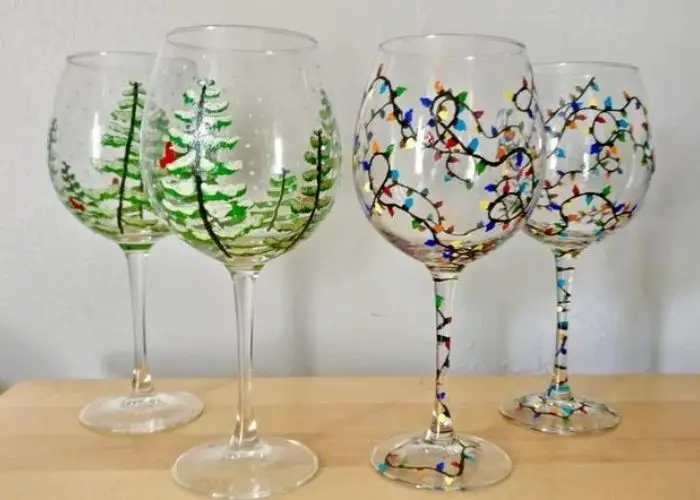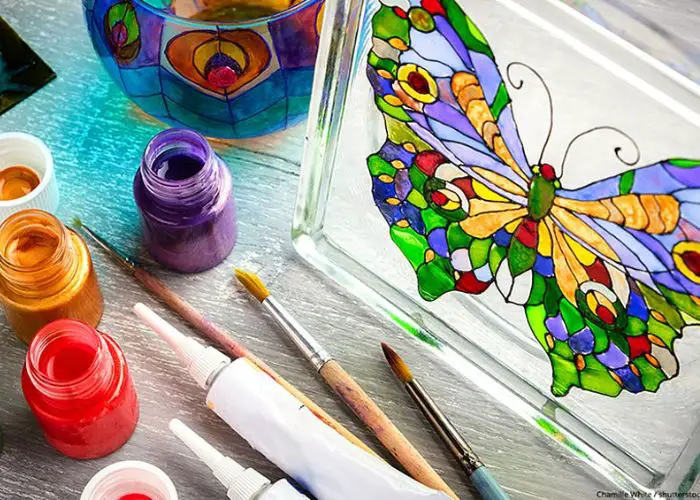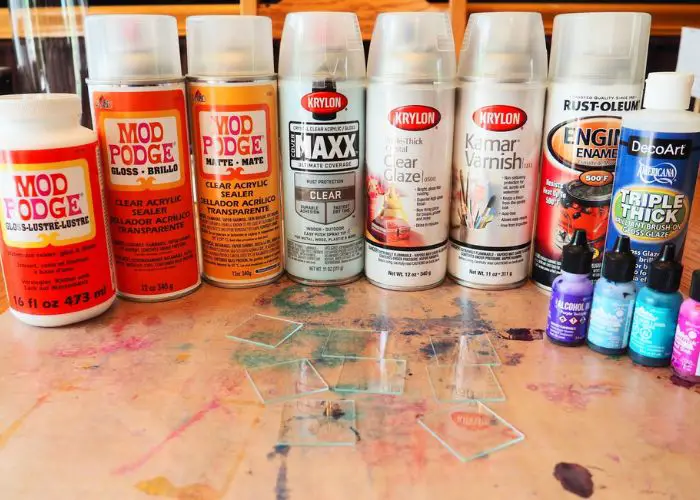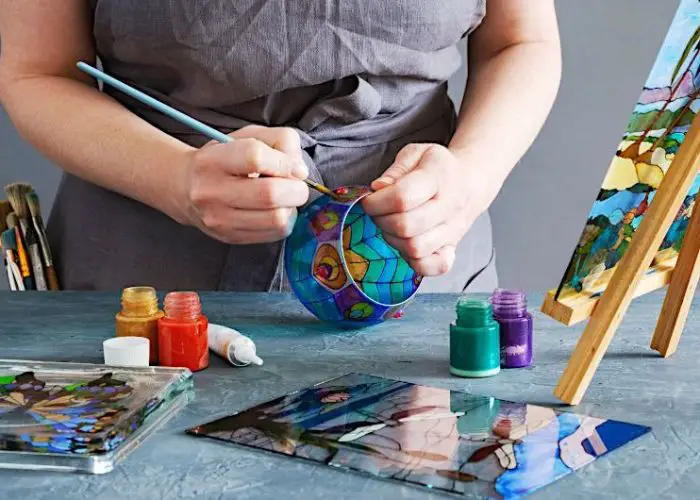Do you want to know how to seal acrylic paint on glass? It’s actually quite easy, but there are a few things you need to keep in mind.
This article will discuss how to choose the right type of acrylic paint for glass, how to prepare the glass, and how to paint on glass with acrylics.
We’ll also recommend a few sets of paints and brushes that you can use.
So whether you’re looking to create a beautiful piece of art or simply want to protect your painted glassware from fading and chipping. Read on for all the information you need!
How to Seal Acrylic Paint on Glass
- Decide how to apply: Spraying or Brushing
- Choose your sealer
- Get a free air space
- Apply first coat of sealer
- Allow the sealer to dry
- Apply another layer of sealer
- Let it dry
Can You Use Acrylic Paints on Glass?

Yes, you can use acrylic paints on glass. In fact, acrylic painting is a great way to add color and personality to any glass surface.
So whether you’re looking to paint a vase, a window, or a piece of drinking glassware, acrylics can help you achieve the look you want.
However, there are a few things to keep in mind when using acrylics on glass.
First, it’s important to choose the right type of paint. Not all acrylic paints are created equal, and some are better suited for use on glass than others. We’ll discuss how to choose the right type of paint later on in this article.
Second, you’ll need to prepare the glass before you start painting. This involves cleaning the glass’s surface and ensuring it’s free of any grease or dirt. We’ll show you how to do this in the next section.
Finally, it’s important to use the right type of brush when painting with acrylics. Choosing a brush with synthetic bristles will help you achieve a smooth, even finish. We’ll talk more about finding the right brush later on.
Does Acrylic Paint Stick to Glass?
Yes, acrylic paint will stick to glass. However, it’s important to choose the right paint type and prepare the glass properly before painting.
If you do not do these things, the paint may not adhere well to the glass or may chip and fade over time.
Painting Glass With Acrylic Paint
Painting glass is a rewarding but challenging task that requires special attention to detail.
Acrylic paint is a versatile medium that can be used to create a variety of effects on glass surfaces.
When painting on glass, it is important to use good quality acrylic paint and to prepare the surface of the glass before beginning.
In case you plan to remove the application, don’t stress how to get paint off of glass windows. Acrylic paint is water-soluble and can be removed with water and soap.
How to Choose the Right Type of Acrylic Paint for Glass

There are many different types of acrylic paint available on the market, and not all of them are suitable for use on glass.
When choosing an acrylic paint for glass, it is important to consider the following factors:
Opacity
You will want to choose an opaque paint if you want to cover up the color of the glass completely.
However, if you’re looking to create a stained glass effect, you’ll want to choose transparent or translucent acrylic paint.
Finish
Acrylic paints come in both matte and glossy finishes. A matte finish will give your painted glass surface a more subdued look, while a glossy finish will make it pop. Here is how to make acrylic painting glossy.
Lightfastness
Lightfastness is the ability of a paint to resist fading when exposed to light. Choosing a, lightfast acrylic paint is important, meaning it won’t fade over time when exposed to sunlight.
Type
There are two main types of acrylic paint: water-based and oil-based. Water-based paints are the most commonly used type of acrylic paint and are also the easiest to clean up.
Oil-based paints take longer to dry, but they’re more durable and resistant to fading.
Consistency
Acrylic paints come in a variety of consistencies, from thick to thin.
You’ll want to choose a thicker paint if you’re looking to achieve an opaque finish, while a thinner paint is better for creating translucent effects.
Acrylic Paint on Glass – Which Paints Are Best
Now that you know what to look for in an acrylic paint for glass, it’s time to choose the right paint for your project. Here’s a review of the best acrylic spray paint for glass to choose from.
Here are a few of our favorite acrylic paints for use on glass:
1. FOLKART Acrylic Craft Paint Set
The FOLKART Acrylic Craft Paint Set is a great option for artists who want to paint on glass.
This set includes 12 vibrant colors that can be used to create a variety of effects. The paints are opaque and come in both matte and glossy finishes.
They’re also lightfast and resistant to fading, making them ideal for outdoor or direct sunlight use.
2. ARTEZA Outdoor Acrylic Paint Set
The ARTEZA Outdoor Acrylic Paint Set is perfect for painters who want to create beautiful outdoor scenes on glass.
This set includes 24 lightfast, fade-resistant colors that can be used to create a variety of effects.
The paints are water-based and have a thick, creamy consistency. They’re also non-toxic and safe for use around children and pets.
3. TMOL Acrylic Paint Set
The TMOL Acrylic Paint Set is a great choice for artists who want to paint on glass.
This set includes 36 high-quality colors that are perfect for a variety of applications.
The paints are lightfast and have a thick, creamy consistency that makes them easy to work with.
The set also includes a variety of finishes, including glossy, flat, matte, and satin.
Also, find out the difference between satin and flat paint.
Finding the Right Paintbrush
Now that you’ve chosen the right paint for your project, it’s time to find the perfect brush. When painting on glass, it is important to use a soft, synthetic brush.
Natural hair brushes can be too rough on the glass and may leave behind unwanted streaks or brush marks.
Which Glass is Best to Paint On?
When painting on glass, choosing a smooth, non-porous surface is important.
Painted glass can be used for a variety of purposes, including windows, vases, and picture frames. If you’re looking for a durable finish, choose tempered glass.
How to Paint Glass with Acrylic Paint – Step by Step
Now that you’ve chosen the right paint and brush for your project, it’s time to get started. Follow these steps to create a beautifully painted glass piece:
Materials and tools
- Glass surface
- Acrylic paint
- Soft, synthetic brush
- Paper towel or soft cloth
Preparing the glass
Before you begin painting, it is important to clean the glass surface. Use a mild soap and water solution to remove any dirt or debris. You can also use rubbing alcohol.
Once the surface is clean, dry it thoroughly with a lint-free cloth. If you’re using a pre-cut stencil, apply it to the smooth glass surface before you begin painting.
Applying the paint – Step by step
Step one: Pour a small amount of paint onto your palette
Begin by pouring a small amount of paint onto your palette. You’ll want to use a fresh, clean palette for each color you use.
Step two: Dip your brush into the paint
Dip your brush into the paint, being sure to load it evenly with pigment.
Step three: Apply the paint to the glass surface
Start by painting the areas that are farthest away from you. Work in small sections and use even, consistent strokes. As you work, keep a wet edge to avoid creating any hard lines.
Step four: Allow the paint to dry
Once you’ve finished painting, allow the paint to dry for 24 hours. If you’re using multiple colors, allow each layer to dry completely before adding the next.
Step five: Apply a second coat of paint (optional)
Once the first coat of paint is dry, you may want to apply a second coat for added coverage.
If you’re using multiple colors, allow each layer to dry completely before adding the next.
Step six: Apply sealer for glass (optional)
Once the paint is dry, you may want to apply a clear sealer to protect it from wear and tear. You can find clear sealers at most hardware stores.
How to Seal Acrylic Paint on Glass – (2 Methods)
Now that you’ve finished painting your glass project, it’s time to seal it. This will protect the paint from chipping, fading, and peeling.
There are two main methods for sealing acrylic paint on glass, paint sealer and heat setting (sealing paint on glass in the Oven).
Method One: Apply a Glass Paint Sealer

Glass paint sealers are available at most craft stores. They come in a variety of finishes, including glossy, matte, and satin.
To apply a glass paint sealer, simply follow the instructions on the bottle.
Read more: Satin vs flat paint.
Painting on Glass with Acrylics: The Best Sealer
When it comes to sealing your painted glass project, there are a few things you’ll want to keep in mind.
First, you’ll need to choose a sealer that is compatible with acrylic paint. Second, you’ll want to make sure the sealer you choose is durable and will protect your project from wear and tear.
And finally, you’ll want to make sure the sealer you choose is easy to apply and will give you the finish you desire.
With so many sealers on the market, it can be hard to know which one to choose. But don’t worry, we’ve got you covered.
Here are two of the best sealers for painting on glass with acrylics.
1. Best Sealer for Spraying: ALEENE’S Spray Gloss Finish
ALEENE’S Spray Gloss Finish is a transparent sealer that provides a high-gloss finish. It’s perfect for protecting your painted glass projects from wear and tear.
The spray applicator makes it easy to apply, and the gloss finish will give your project a finished look.
So if you are looking for the best sealer for spraying, this is the one you want.
2. Best Sealer for Brushing: Mod Podge Gloss Finish
Mod Podge Gloss Finish is a water-based sealer that provides a high-gloss finish. It’s perfect for protecting your painted glass projects from wear and tear.
The brush-on applicator makes it easy to apply, and the gloss finish will give your project a finished look.
If you are looking for the best brush on sealant, this is the one you want.
How to apply a glass paint sealer
To seal paint on glass, simply follow the instructions on the bottle. Most glass paint sealers are applied with a spray applicator or brush-on applicator.
Spraying:
If you are using a spray applicator, be sure to hold the nozzle about 12 inches from the surface of your project.
Then, apply a light, even coat of sealer to the surface of your project. Allow the sealer to dry for about 30 minutes before handling.
Brushing:
If you are using a brush-on applicator, apply a thin, even layer of sealer to the surface of your project. Allow the sealer to dry for about 30 minutes before handling.
Applying a clear sealer to your project will protect the paint from chipping, fading, and peeling. It’s an important step in ensuring your project lasts for years to come.
Method Two: Heat Setting (Sealing paint on glass in the Oven)
Can you bake acrylic paint on glass? What is heat setting? Heat setting is a method of sealing paint that uses heat to set the pigment into the glass.
This method is often used for projects that will be exposed to high temperatures, such as dishes and glasses.
How to bake acrylic paint on glass
To heat-set your project, simply follow these instructions:
- Preheat your Oven to 350Ovenrees Fahrenheit.
- Place your project on a baking sheet or parchment paper and bake for 30 minutes.
- Remove your project from the Oven and allow it to cool completely.
- Once your project is cooled, it is safe to use.
Baking your project in the Oven will heat pigment into the glass and provide a durable finish.
This method is perfect for projects that will be used in the kitchen, such as dishes and glasses.
Note: You can also try using the chemical sealant method, but this is only recommended for non-food surfaces.
Interesting Read: How to Seal Acrylic Paint on Leather Bag
Tips for Successful Sealing
Now that you know how to seal your painted glass project, here are a few tips for successful sealing:
- Make sure the surface of your project is clean and free of dirt and dust before applying the sealer.
- Spray on sealant in a well-ventilated area.
- Follow the instructions on the bottle of sealer.
- Allow the sealer to dry completely before using your project.
Sealing your painted glass project is an important step in ensuring its longevity. By following these tips, you’ll be sure to get a perfect finish every time.
Painted Glass Safety Tips
Before you begin your next glass painting project, be sure to read and follow these safety tips:
- Wear gloves to protect your hands from the paint.
- Work in a well-ventilated area.
- Avoid inhaling the fumes from the paint.
- Keep children and pets away from the area while you are working.
How to Seal Acrylic Paint on Wood
Here’s a basic guide on how to seal acrylic on wood so your masterpiece can stay looking great for years to come.
First, start by sanding the wood smooth. This will help the sealant to adhere better and also create a nice surface for your paint.
Next, wipe the wood down with a damp cloth to remove any dust. Once it’s dry, apply a thin layer of sealant evenly over the surface using a brush or roller.
Be sure to get into all the nooks and crannies so your paint is properly protected. Allow the sealant to dry completely before moving on to the next step.
Now it’s time to add your final coat of paint! Choose a color that you love and go for it. Once the paint is dry, enjoy your newly sealed and protected artwork!
Related Read: How to Seal Acrylic on Plastic.
How to Seal Paint on Phone Case
Here is a guide on sealing acrylic paint on a phone case effectively.
Once you have completed painting the phone case with acrylic paint and allowed it to dry completely, it’s crucial to take the necessary steps to protect and preserve your artwork.
To seal the paint, start by selecting a clear sealant that is compatible with acrylic paint and suitable for the material of the phone case.
Whether you choose a brush-on or spray-on sealant, make sure to apply it evenly across the painted surface, following the instructions provided by the manufacturer.
This sealant will provide a protective layer, guarding against chipping, scratching, and fading, and ensuring that your customized phone case remains vibrant and intact for an extended period.
FAQs
What can I use to seal acrylic paint on glass?
You can use a few different options to seal your painted glass project, including spray-on sealers and brush-on sealers. You can also heat set your project in the Oven to provide a durable finish.
How do I keep my paint from peeling off glass?
To prevent your paint from peeling off the glass, clean the surface of your project before painting. Then, apply a thin, even layer of paint to the glass, and allow it to dry completely before handling. You can also apply a clear sealer to your project to provide additional protection.
Can I use acrylic paint on wine glasses?
Yes, you can use acrylic paint on wine glasses. Of course, you can also use other types of paint, but acrylics are the most popular. They’re easy to find, come in a variety of colors, and can be found at any craft store.
How do you seal acrylic paint on glass at home?
You can use several methods to seal your painted surface project at home. The best method is to bake your project in the Oven. This Oven not only seals your paint but will also cure it so that it is dishwasher safe.
Can I use Mod Podge to seal acrylic paint on glass?
Mod Podge can be used as a sealer for acrylic paint on glass. However, it is not permanent and must be reapplied every few months.
How can I seal a glass fish tank?
To seal a glass fish tank, start by cleaning and drying the tank. Then, use a fish tank safe paint, such as aquarium-grade silicone sealant, along the seams. Apply it evenly and allow it to cure according to the manufacturer’s instructions before filling the tank with water and adding fish.
Conclusion
Sealing your painted glass project is an important step in ensuring its longevity.
By following these tips, you’ll be sure to get a perfect finish every time.
We hope this article was helpful. If you have any questions, feel free to leave them in the comments below.
Happy painting!
Read also: How to drill plexiglass without cracking











Leave a Reply